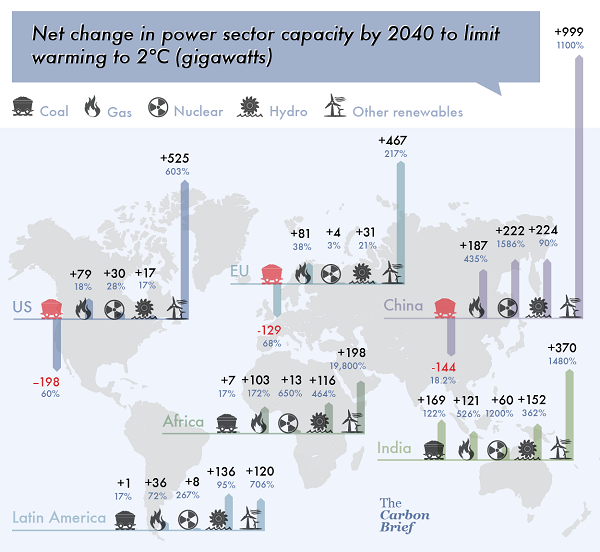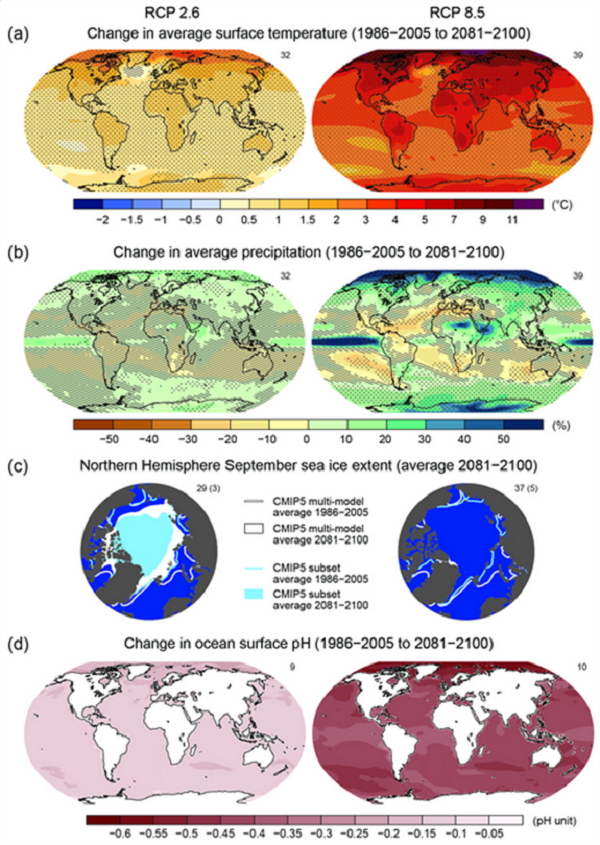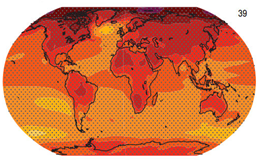Carbon Brief has compiled a series of three posts on the so-called 2°C ‘guardrail’ used in global warming discourse:
This post will pick out some of the highlights, but is not a substitute for reading the posts.
The history of two degrees
To me there have been four critical events:
- From 1975 Yale economics professor William Nordhaus suggested that warming of more than two degrees would push the climate beyond the limits humans were familiar with.
- In 1990 a team of researchers from the Stockholm Environment Institute (SEI) attempted to define what constituted dangerous climate change. They suggested two degrees.
- In 1996 the European Council of environment ministers declared that “global average temperatures should not exceed 2 degrees above pre-industrial level”.
- At the Conference of Parties of the UNFCCC in Cancun in 2010 governments committed to “hold the increase in global average temperature below 2°C above pre-industrial levels.”
Notably the SEI in 1990 was nuanced and cautious:
-
Based on scientific understanding at the time, SEI suggested that to avoid the worst impacts of climate change, a limit should be set at two degrees. But, the report warned, the higher the temperature rise, the bigger the risks from climate change.
“Temperature increases beyond 1.0°C may elicit rapid, unpredictable, and non-linear responses that could lead to extensive ecosystem damage,” the report said, suggesting there is nothing necessarily ‘safe’ about a two degree limit. (Emphasis added)
In their view 2°C was not a guardrail where it was safe on one side and dangerous on the other. In my view the notion of a ‘guardrail’ is majorly misleading.
Can we avoid dangerous climate change?
The distilled wisdom is that we have a historical emissions budget of 2,900 billion tonnes of carbon dioxide if we are to have a 66% chance of staying below two degrees. We’ve used up 1,900 of that budget so the remaining budget is 1000 billion tonnes. At current rates we’ll use up that budget in 21 years. Unfortunately emissions are increasing.
If emissions were to peak today they would need to start falling at 5.5% per year from tomorrow, in order to achieve a 66% chance of staying within a two degrees increase. France managed 5% per year for half a decade at the height of its 30-year shift to nuclear, during which it went from one per cent nuclear-powered to 80%. That kind of effort would be required worldwide on average for decades.
Increasingly the assumption is that we need to reach zero net emissions around 2055 to 2070 and then go net negative, using technology that has not yet been developed.
The article canvasses a number of stabilisation strategy scenarios and includes this interesting map of electricity generation change required by 2040 from the International Energy Association’s World Energy Outlook 2014:

The message is that the investment in renewables needs to be massive. Coal must reduce in the US, the EU and China, but could increase elsewhere, substantially so in India. Everyone will use more gas.
I would query the role of gas as a transition technology for two reasons. Firstly, I think we need to decarbonise so rapidly that gas would need to be phased out before an adequate return on investment is achieved. Secondly, I’m concerned about its true greenhouse effectiveness, because of fugitive emissions in production, transmission and usage, and because I think the greenhouse impact of methane is underestimated.
It’s no surprise that I would also query the accepted wisdom about the remaining carbon budget. A one third chance of failure is unacceptable, David Spratt points out that if we want a 90% chance of success there is no carbon budget left.
I agree with the article that we should never call “game over” in climate mitigation efforts.
See also my post The UNEP Emissions Gap Report: a failure of ambition.
What happens if we overshoot two degrees?
There is much uncertainty about the specifics, but this mega graphic gives the overall impact of four degrees as against two degrees in four aspects:

The article says that change should be seen as a continuum rather than as a precipice. I’d agree, but I think we should assume that a precipce that we can’t see is there and the chances of meeting up with it increase as the temperature increases. In short, the more warming we have the more we are likely to trigger tipping points that make the climate less stable.
I have a massive query with this statement:
-
Global temperature has risen 0.85 degrees Celsius since 1880, according to the latest report from the Intergovernmental Panel on Climate Change (IPCC).
We could be due another couple of tenths on top of that as past emissions take a decade or so to reach their full effect warming. Together with current and expected emissions we’re essentially already committed to about one degree of warming, scientists estimate.
The article cites one study that sees warming effects flowing through in about a decade. I suspect that only short-term feedbacks are being considered.
David Spratt’s paper Is climate change already dangerous? says:
-
And the IPCC (2007) Synthesis report (Table 5.1 on emission scenarios) also shows that for levels of greenhouse gases that have already been achieved (CO2 in the range of 350–400 ppm,CO2e in the range 445–490 ppm) and peaking by 2015, the likely temperature rise is in the range of 2–2.4°C.
I’ll finish with a reminder that the Swedes got it right – two degrees does not mean a safe climate.
See also my The folly of two degrees: Climate Code Red.


Brian
If that is true, considering the world population was about 1.5 billion in 1880 and now 7.3 and expected to be 9.5 ish by 2050 my question is;
Other than co2 emissions from fossil fuels burning what percentage of the warming can be attributed to other human activities like deforestation/desertification, actual heat from our activities, modern agricultural activities rather than foraging, our effects on clouds( non co2 and ch4 )… ?
Sort of, like, how much is the balance tilted by activities other than burning fossil fuels for energy ( as best as you can tell ) ?
Hey jumpy, this is the internet. There’s a great tool you can use (I think it’s called Google) to find out all sorts of things. I believe Brian probably uses it frequently. Why don’t you?
In fact, let me Google that for you
Hey thanks zoot!
Your a proper little Xmas time helper you are.
But you may have noticed in that googol thingumajig that a few ” answers ” revealed wouldn’t pass Brains ” trust/underestimate/overestimate/BS ” test ?
I was asking, at his place, his opinion of best estimate.
But since your in such a helpful mood, toddle of and find a graph that plots emissions by fossil fuel energy burning as a % as well as emissions by other, year on year since 1880 and projected out till 2050, overlaid with population growth.
Should be a cinch for a trooper with the internet skills that you possess, alas, I admit my skills fall short.
And then we’ll let Brian give in the sniff test.
Again, thanks for your help.
opps!
See I even accidentally misspelled Brians name in the first paragraph.
Thankfully there are folks like zoot that see ” computer unfamiliarity disorder ” as a genuine problem in todays society that needs help rather than mocking.
I do appreciate it.
Jumpy, I’m not sure that what you require @ 4 exists. In answer to your @ 1, from memory last time I looked fossil fuel burning produced about 36 or 37 billion tonnes of CO2 pa and the total including forestry etc was the equivalent of about 51 billion tonnes. Some of that is going to be very difficult to deal with.
Not sure what graphing population over emissions and other would prove. We know that as per capita GDP increases, so do per capita emissions.
Perform a search for a person and you answer their question.
Show them how to use Google and they’ll never whinge again.
As if.
Brian
I get from %17 to %34 depending on ” good old google ” results ( thanks again zoot [ who came up blank, again])
If this link works we see deforestation since 2001.
You admit population growth drives emissions, how do we address this ?
Iv’e seen it written that medical advances are the prime cause of population growth, do you agree or do think it’s something else.
( for zoots benefit I googled ” what does Brian think about ..[ insert topic ] ” and found no joy, I must be doing it wrong )
In short, educate and liberate women.
Also public health, sanitation, clean water etc.
Ahh, the tyranny of helplessness.
Jumpy, have you been a victim all your life or is it a recent development?